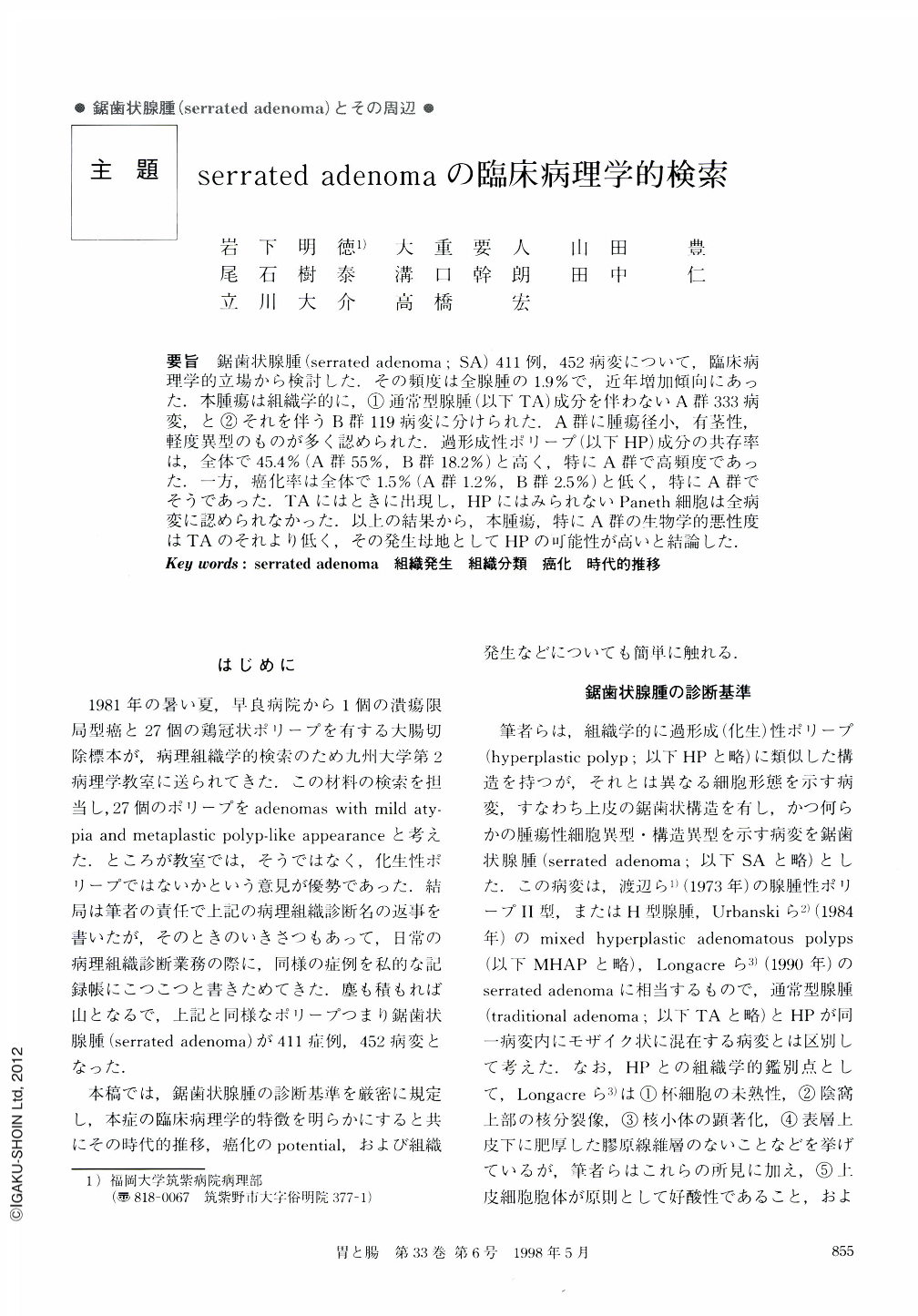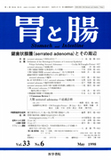Japanese
English
- 有料閲覧
- Abstract 文献概要
- 1ページ目 Look Inside
- サイト内被引用 Cited by
要旨 鋸歯状腺腫(serrated adenoma;SA)411例,452病変について,臨床病理学的立場から検討した.その頻度は全腺腫の1.9%で,近年増加傾向にあった.本腫瘍は組織学的に,①通常型腺腫(以下TA)成分を伴わないA群333病変,と②それを伴うB群119病変に分けられた.A群に腫瘍径小,有茎性,軽度異型のものが多く認められた.過形成性ポリープ(以下HP)成分の共存率は,全体で45.4%(A群55%,B群18.2%)と高く,特にA群で高頻度であった.一方,癌化率は全体で1.5%(A群1.2%,B群2.5%)と低く,特にA群でそうであった.TAにはときに出現し,HPにはみられないPaneth細胞は全病変に認められなかった.以上の結果から,本腫瘍,特にA群の生物学的悪性度はTAのそれより低く,その発生母地としてHPの可能性が高いと結論した.
Clinicopathological study of serrated adenoma (SA) of the large intestine was carried out in 452 specimens consisting of 233 polypectomy specimens, 193 biopsy specimens and 26 surgically resected specimens, which were obtained from 411 patients. The results obtained were as follows:
(1) Serrated adenomas comprised 1.9% of all adenomas of the large intestine, and the incidence has recently increased.
(2) The patients with SA ranged in age from 28 to 92 years (mean 62.0±12.5) and male to female ratio was 1.7:1. SA was most frequently observed in the rectosigmoid colon (275 of 452 lesions). Thirty patients had two or more SA; the greatest number in any one patient being four.
(3) Three hundred and one of 452 SA were sessile in shape, and the remaining SA were pedunculated (121 SA) and subpedunculated (30 SA) in shapes, respectively. No SA of depressed type was noted. The average largest diameter was 9.1±4.5 mm, ranging from 2 to 25 mm. Seventy-three percent of the lesions were small, measuring 2 to 10 mm. Endoscopically, seventy-three percent of SA had reddish surface color.
(4) Serrated adenomas studied were histologically classified into two groups as follows; SA without traditional adenomatous component (TAC) (333 lesions) and SA with TAC (119 lesions). According to manner of distribution of SA and TA elements, the latter was divided into three subtypes as follows; mixed type (96 lesions), separate type (20 lesions), and mixed + separate type (3 lesions).
(5) The average largest diameter was larger in SA with TAC than in SA without TAC, and the lesions of pedunculated type were more frequently found in SA without TAC than in SA with TAC, with statistically significant difference.
(6) Two hundred and five of the 452 lesions (45.4%) had the component of hyperplastic polyp. The incidence was statistically significantly higher in SA without TAC (55%) than in SA with TAC (18.5%).
(7) Histologically, eighty-one percent of the serrated adenomas showed mild atypia, and nineteen percent of SA revealed moderate atypicality. The number of SA with mild atypia was greater in SA without TAC than SA with TAC, with statistically significant difference.
(8) Sixty percent of the lesion had broad stroma with many capillaries, which may cause the endoscopical redness.
(9) Mucus-producing cells including goblet cells with various degrees of differentiation were recognized in all lesions, but neoplastic Paneth cells were not found in all SA.
(10) Only seven (1.5%) of the SA contained foci of intramucosal well differentiated adenocarcinoma. Six of the seven SA with carcinomatous foci were larger than 10 mm, and the atypia of the seven SA was moderate in six lesions and severe in one lesion.
In conclusion, it was shown that serrated adenoma of the large intestine has a lower malignant potential than traditional adenoma, and that they may reflect a neoplastic transformation of the epithelial cells of hyperplastic polyp.

Copyright © 1998, Igaku-Shoin Ltd. All rights reserved.


